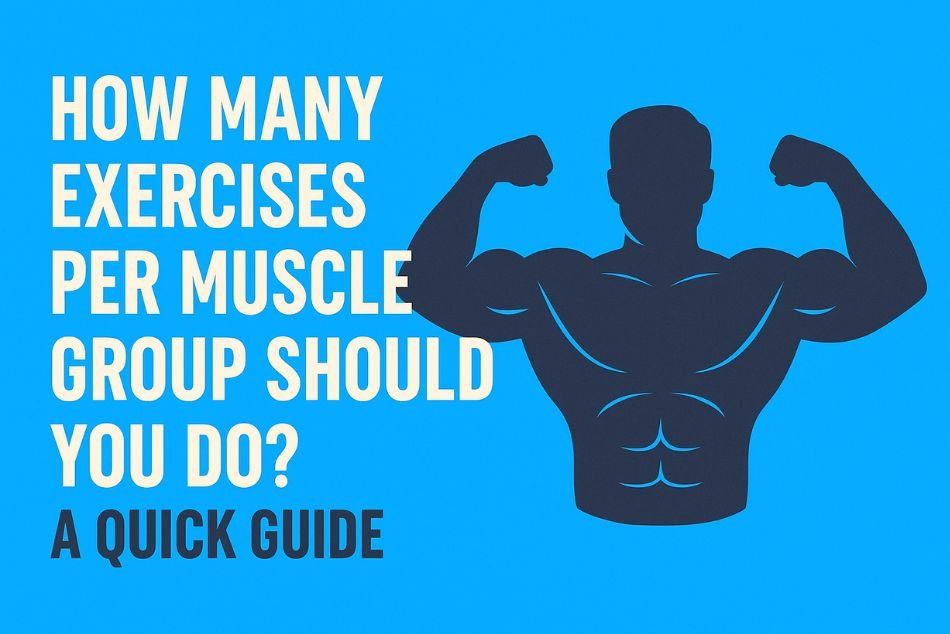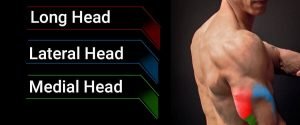How Many Exercises per Muscle Group Should You Do for Optimal Growth?
When it comes to building muscle efficiently, one of the most common questions gym-goers ask is: how many exercises per muscle group should I do? The answer is not the same for every muscle. Different muscles have different fiber arrangements, heads, and functions, which means the number of exercises needed for optimal growth varies.
Some muscles, like the biceps, can thrive with a single focused exercise, while larger, more complex muscles like the chest, back, or glutes benefit from multiple exercises targeting their different sections.
In this guide, we’ll explore everything you need to know about training volume, exercise selection, set distribution, and how to plan your workouts to maximize muscle growth. By the end, you’ll know exactly how many exercises per muscle group to include in your training program for each body part.

Understanding What Determines Exercise Volume
Before diving into specific muscles, it’s important to understand why some muscles need more exercises than others. Muscle growth, or hypertrophy, depends on stimulating the muscle fibers with sufficient intensity and volume. Muscles are made up of thousands of fibers arranged in different directions and grouped into multiple heads. Only the fibers that are sufficiently stressed will adapt and grow.
Factors influencing how many exercises you need include:
- Muscle Fiber Orientation – Muscles like the chest have fibers running in multiple directions. Flat presses target the middle fibers, incline presses emphasize the upper fibers, and decline presses or dips hit the lower portion.
- Number of Muscle Heads – Muscles like the triceps have three heads with different functions. You need different exercises to target each head effectively.
- Muscle Function – Muscles that perform multiple movements require exercises that train each function, such as the hamstrings (hip extension and knee flexion).
- Training Experience – Beginners often make gains with fewer exercises, while advanced lifters require more variety and volume.
Research shows that most muscles benefit from 10–15 sets per week, but the distribution of sets across exercises depends on the muscle’s structure.
How Many Sets Should You Do per Exercise?
Scientific studies suggest that to maximize hypertrophy, each muscle should receive at least 10 sets per week. Experienced lifters may see better growth with 15–20 weekly sets.

Here’s how to allocate sets effectively:
- Single-Head Muscles: 10–12 sets per week of 1–2 exercises (e.g., biceps brachii, brachialis).
- Multi-Head or Multi-Function Muscles: Divide sets across 2–4 exercises that target different heads or functions (e.g., chest, triceps, hamstrings).
- Overlapping Muscles: Some exercises work multiple muscles at once. Account for this overlap when distributing sets.
Upper Body
Chest
The chest, or pectoralis major, is one of the most prominent upper body muscles. It consists of fibers running in multiple directions and requires targeted exercises to fully stimulate growth.
Optimal Exercises
- Flat Press (Barbell or Dumbbell) – Hits most middle chest fibers.
- Incline Press (Barbell, Dumbbell, or Cable) – Targets the upper chest.
- Decline Press/Dips/Cable Fly – Engages lower chest fibers.
Set Recommendation
Distribute 10–15 sets per week across these exercises. For example, 3–5 sets per variation.
Additional Tips
- Use progressive overload: gradually increase weight or reps.
- Include isolation work like cable flyes to maximize chest contraction.
- Vary rep ranges: low (5–8), medium (8–12), and high (15–20) for complete fiber activation.
Sample Chest Workout
- Barbell Bench Press: 4 sets x 6–8 reps
- Incline Dumbbell Press: 3 sets x 10 reps
- Dips (weighted if possible): 3 sets x 12 reps
- Cable Chest Fly: 3 sets x 15–20 reps
Back
The back consists of multiple muscles that perform different functions. These can be categorized as:
- Back Extensors – Erector spinae, multifidus (spine extension).
- Vertical Pulling Muscles – Lats, lower traps (pulling arms from overhead).
- Horizontal Pulling Muscles – Lats, rhomboids, traps (pulling arms from in front).
Optimal Exercises
- Back Extension: Deadlift, Rack Pull, Good Morning, Back Extension
- Vertical Pull: Pull-Up, Lat Pulldown, Chin-Up
- Horizontal Pull: Barbell Row, Dumbbell Row, Cable Row
Set Recommendation
Divide 10–15 weekly sets evenly. Example: 3–5 sets per category.
Sample Back Workout
- Deadlift: 3 sets x 5 reps
- Pull-Up: 3 sets x 8–10 reps
- Dumbbell Row: 3 sets x 10 reps
- Cable Row: 3 sets x 12 reps
- Back Extension: 3 sets x 15 reps
Additional Tips
- Mix grip variations (overhand, underhand, neutral) to recruit different fibers.
- Focus on mind-muscle connection, especially for lats and traps.
- Include both heavy compound lifts and isolation movements for balanced development.
Shoulders
The deltoids have three heads: front, lateral, and rear. Training each head ensures full development.
Optimal Exercises
- Front Delts: Overhead Press, Dumbbell Press, Front Raise
- Lateral Delts: Dumbbell Lateral Raise, Upright Row, Overhead Press
- Rear Delts: Reverse Dumbbell Fly, Face Pull, Barbell Rear Delt Row
Set Recommendation
Aim for 10–15 sets per week per head, factoring in overlap from pressing or rowing movements.
Sample Shoulder Workout
- Overhead Press: 4 sets x 6–8 reps
- Dumbbell Lateral Raise: 3 sets x 12 reps
- Barbell Front Raise: 3 sets x 10 reps
- Reverse Fly: 3 sets x 12 reps
- Face Pull: 3 sets x 15 reps
Tips
- Avoid overloading front delts with pressing exercises alone.
- Use controlled tempo for lateral and rear delt isolation.
- Prioritize shoulder health with warm-ups and mobility work.
Biceps
The biceps consist of the biceps brachii (two heads) and brachialis. The muscle functions include elbow flexion and forearm supination.
Optimal Exercises
- Barbell Curl (both heads)
- Dumbbell Hammer Curl (brachialis emphasis)
- Preacher Curl or Cable Curl (isolation and peak contraction)
Set Recommendation
10 weekly sets are sufficient for beginners, distributed among exercises if using multiple variations.
Sample Bicep Workout
- Barbell Curl: 3 sets x 8 reps
- Hammer Curl: 3 sets x 10 reps
- Preacher Curl: 3 sets x 12 reps
Tips
- Perform slow eccentric phases for better hypertrophy.
- Use unilateral exercises to correct imbalances.
- Avoid swinging or using momentum to lift.
Triceps
The triceps have three heads: long, lateral, and medial. Different angles and movements are needed to target all heads.
Optimal Exercises
- Press: Close-Grip Bench Press, Dips, Overhead Press
- Extension at Long Muscle Length: Overhead Cable Extension, Dumbbell Overhead Extension
- Extension at Short Muscle Length: Tricep Pushdown, Rope Pushdown
Set Recommendation
Distribute 10–15 weekly sets evenly across exercises.
Sample Triceps Workout
- Close-Grip Bench Press: 3 sets x 8 reps
- Overhead Cable Extension: 3 sets x 12 reps
- Triceps Pushdown: 3 sets x 15 reps
Tips
- Use full range of motion to stimulate all heads.
- Incorporate unilateral work to address strength imbalances.
Lower Body
Quads
The quadriceps have four muscles: vastus lateralis, vastus intermedius, vastus medialis, and rectus femoris. The rectus femoris crosses both the hip and knee joint.
Optimal Exercises
- Squats, Leg Press, Hack Squat (compound movements)
- Bulgarian Split Squat, Lunges (unilateral control)
- Leg Extension (rectus femoris isolation)
Set Recommendation
10–15 weekly sets, divided among squatting, unilateral, and isolation exercises.
Sample Quad Workout
- Barbell Squat: 4 sets x 6–8 reps
- Bulgarian Split Squat: 3 sets x 10 reps
- Leg Extension: 3 sets x 15–20 reps
Glutes
The glutes consist of gluteus maximus, medius, and minimus, with primary functions in hip extension, rotation, and abduction.
Optimal Exercises
- Hip Extension: Squat, Deadlift, Hip Thrust
- Unilateral Stabilization: Bulgarian Split Squat, Lunges
- Hip Abduction: Band Side Kicks, Cable Abductions
Set Recommendation
10–15 sets per week for hip extension, plus 5–10 sets for abduction.
Sample Glute Workout
- Barbell Hip Thrust: 4 sets x 8 reps
- Romanian Deadlift: 3 sets x 12 reps
- Bulgarian Split Squat: 3 sets x 15 reps
- Band Side Kick: 3 sets x 20 reps
Hamstrings
Hamstrings are biarticular muscles performing hip extension and knee flexion.
Optimal Exercises
- Hip Extension: Romanian Deadlift, Good Morning
- Knee Flexion: Seated or Lying Leg Curl
Set Recommendation
10–15 weekly sets, evenly split between hip extension and leg curl movements.
Sample Hamstring Workout
- Romanian Deadlift: 4 sets x 8 reps
- Seated Leg Curl: 3 sets x 12 reps
- Lying Leg Curl: 3 sets x 15 reps
Calves
Calves include the gastrocnemius and soleus. Both extend the foot, but soleus is more active in seated positions.
Optimal Exercises
- Standing Calf Raise (gastrocnemius dominant)
- Seated Calf Raise (soleus dominant)
- Eccentric Heel Drops (additional overload)
Set Recommendation
10–15 sets per week, mostly standing exercises.
Sample Calf Workout
- Standing Calf Raise: 4 sets x 8–12 reps
- Seated Calf Raise: 3 sets x 15–20 reps
- Heel Drop: 3 sets x 10–12 reps
Tips for Maximum Muscle Growth
- Frequency: Train each muscle 1–3 times per week depending on experience and recovery.
- Progressive Overload: Gradually increase weight, reps, or sets to stimulate growth.
- Rest Between Sets: 60–120 seconds for isolation, 2–4 minutes for heavy compound lifts.
- Volume vs Intensity: Adjust total weekly sets based on recovery capacity and experience.
- Mind-Muscle Connection: Focus on contraction and proper form for maximal stimulation.
Nutrition and Recovery
Muscle growth is impossible without proper nutrition and recovery:
- Protein: Aim for 1.6–2.2 g/kg of body weight per day.
- Calories: Maintain a slight surplus to fuel growth.
- Sleep: 7–9 hours per night for recovery and hormone regulation.
- Active Recovery: Light cardio, mobility work, and stretching aid recovery.
Conclusion: How Many Exercises per Muscle Group Really Matters
Determining how many exercises per muscle group depends on anatomy, function, and your training experience. Multi-headed muscles like triceps or chest require multiple exercises, while simpler muscles like biceps may grow with fewer. Focus on proper exercise selection, set distribution, progressive overload, and recovery. With consistency and intelligent programming, you can maximize muscle growth efficiently and safely.
Frequently Asked Questions
Q1) Can I Train Large and Small Muscles the Same Way?
Not always. Large muscles often require more exercises to hit different heads and fiber angles, while small muscles may grow with 1–2 exercises.
Q2) How Many Sets per Exercise Is Ideal?
3–5 sets per exercise are effective; total weekly sets are more important than sets per session.
Q3) Can I Skip Isolation Exercises?
Compound movements cover most fibers, but isolation exercises help target neglected areas and improve symmetry.
Q4) How Long Until I See Results?
Beginners may notice growth in 6–8 weeks. Intermediate lifters may see progress in 8–12 weeks depending on volume, nutrition, and recovery.






